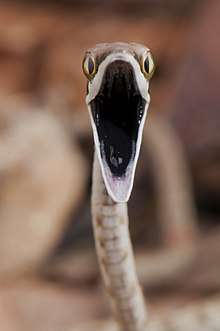Oxybelis aeneus
| Oxybelis aeneus | |
|---|---|
 | |
| Scientific classification | |
| Kingdom: | Animalia |
| Phylum: | Chordata |
| Class: | Reptilia |
| Order: | Squamata |
| Suborder: | Serpentes |
| Family: | Colubridae |
| Genus: | Oxybelis |
| Species: | O. aeneus |
| Binomial name | |
| Oxybelis aeneus (Wagler, 1824) | |
| Synonyms | |
| |

Oxybelis aeneus, commonly known as the Mexican vine snake or brown vine snake, is a species of colubrid snake, which is endemic to the Americas.
Geographic range
O. aeneus is found from southern Arizona in the United States,[5] through Mexico, to northern South America and Trinidad and Tobago.
Description
O. aeneus is an extremely slender snake that reaches up to 1.9 metres (6.2 ft) in total length (including a long tail). Its color may vary from gray to brown with a yellow underside.
The body is laterally compressed.[3] The snout is prominent, its length more than two times the diameter of the eye. There is 1 preocular, and there are 2 postoculars. There is 1 anterior temporal, and there are 2 posterior temporals.[2] There is no loreal scale, and there are 8-10 upper labials.[4]
The smooth dorsal scales are arranged in 17 rows at midbody.[2]
Ventrals 173-205;[4] subcaudals 150-188, divided (paired).[2] The anal plate is divided in Arizona specimens,[3] but is entire in South American specimens.[2]
Common names
In Arizona O. aeneus is also called "pike-headed tree snake".[3] In Trinidad and Tobago and Guyana, it is known as a "horse whip" or "vine snake".
Behavior
Mostly arboreal and diurnal, O. aeneus is quite often mistaken for a vine. When threatened, it sometimes releases foul smelling secretions from its vent.
Diet
O. aeneus feeds mainly on lizards, but also eats frogs and birds.
Venom
O. aeneus is a mildly venomous rear-fanged snake, but it is not considered dangerous to humans. However, a bite can cause an itching sensation.
Reproduction
O. aeneus is oviparous. Clutch sizes of 3-6 have been published. In Arizona, hatching occurs in September.[6]
References
- 1 2 "Oxybelis aeneus ". The Reptile Database. www.reptile-database.org.
- 1 2 3 4 5 Boulenger, G.A. (1896). Catalogue of the Snakes in the British Museum (Natural History). Volume III., Containing the Colubridæ (Opisthoglyphæ and Proteroglyphæ) ... London: Trustees of the British Museum (Natural History). (Taylor and Francis, printers). xiv + 727 pp. + Plates I-XXV. (Oxybelis argenteus, pp. 190-191).
- 1 2 3 4 Wright, A.H.; Wright, A.A. (1957). Handbook of Snakes of the United States and Canada. Ithaca and London: Comstock. 1,105 pp. (in 2 volumes) (Oxybelis aeneus auratus, pp. 563, 565-569, Figure 167, Map 44).
- 1 2 3 Smith, H.M.; Brodie, E.D., Jr. (1982). Reptiles of North America: A Guide to Field Identification. New York: Golden Press. 240 pp. ISBN 0-307-13666-3 (paperback). (Oxybelis aeneus, pp. 188-189).
- ↑ Brennan, Thomas C. "Brown Vine Snake (Oxybelis aeneus)". Online Field Guide to the Reptiles and Amphibians of Arizona. Retrieved 2009-06-25.
- ↑ Goldberg, S.R. (1998). "Reproduction in the Mexican vine snake Oxybelis aeneus ". Texas Journal of Science 50 (1): 51-56.
Further reading
- Behler, John L.; King, F. Wayne (1979). The Audubon Society Field Guide to North American Reptiles and Amphibians. New York: Alfred A. Knopf. 743 pp. ISBN 0-394-50824-6. (Oxybelis aeneus, pp. 641-642).
- Boos, Hans E.A. (2001). The Snakes of Trinidad and Tobago. College Station, Texas: Texas A&M University Press. ISBN 1-58544-116-3.
- Schmidt, Karl P.; Davis, D. Dwight (1941). Field Book of Snakes of the United States and Canada. New York: G.P. Putnam's Sons. 365 pp. (Oxybelis microphthalmus, pp. 266-268, Figure 88).
- Stebbins, Robert C. (2003). A Field Guide to Western Reptiles and Amphibians, Third Edition. The Peterson Field Guide Series ®. Boston and New York: Houghton Mifflin. xiii + 533 pp. ISBN 0-395-98272-3. (Oxybelis aeneus, pp. 402-403 + Plate 47 + Map 144).
- Wagler, "Jean" [sic] (1824). "Serpentum Brasiliensium species novae, ou histoire naturelle des espèces nouvelles de serpens, recueillies et observées pendant le voyage dans l'intèrieur du Brésil dans les années 1817, 1818, 1819, 1820, exécuté par ordre de sa Majesté le Roi de Baviére ". In: Spix, '"Jean de" [sic] (1824). Animalia nova sive species novae. Munich: F.S. Hübbschmann. viii + 75 pp. + Plates I-XXVI. (Dryinus aeneus, new species, pp. 12–13 + Plate III). (in Latin and French).
- Zim, Herbert S.; Smith, Hobart M. (1956). Reptiles and Amphibians: A Guide to Familiar Species: A Golden Nature Guide. New York: Simon and Schuster. 160 pp. (Oxybelis aeneus, pp. 82, 84, 156).
External links
- Oxybelis aeneus eating a rosebelly lizard (Sceloporus variabilis)
- Species Oxybelis aeneus at The Reptile Database